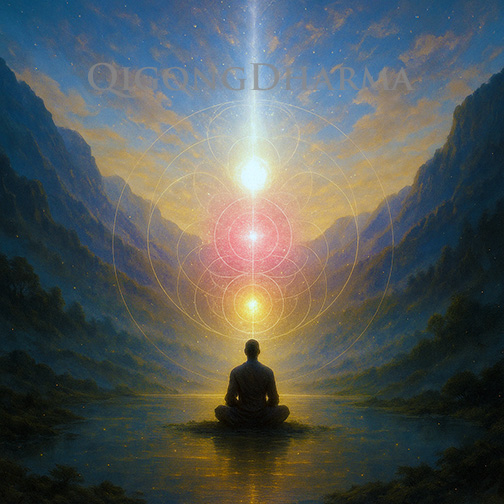The Three Centers in QigongDharma
The Axis of Original Spirit
A Reflection by Roshi Teja Fudo Myoo Bell
When I teach QigongDharma, I often speak of the Three Centers — the Lower, the Middle, and the Upper Dantian (丹田).
I frequently use the Japanese term hara (腹) for the lower Dantian, so the centers become: Head, Heart, and Hara. These are not merely points within the body or abstract symbols; they are living fields of awareness, balanced through practice, forming the vertical axis of our being — what Daoist adepts call the Taiji Pole (太極樞), also known as the Central Channel (中脈), through which flows the living current of the Original Spirit (Yuan Shen 元神).
The Lower Center — Foundation of Life
At the base of our being, just below the navel and in the true center of the lower body, lies the Lower Dantian (下丹田) — the Center of Gravity and the wellspring of vitality. Here Jing (精), the essence of life, gathers and condenses; here breath deepens into stillness.
In modern physiological language, this corresponds to the enteric nervous system, the “second brain” of the abdomen — a vast network of hundreds of millions of neurons silently regulating digestion, immunity, and mood. To feel from this center is to reclaim our natural, deeply intuitive wisdom — the steady pulse of life itself.
Through standing meditation, through stillness, and through gentle movement, we invite awareness to descend from the restless mind into the living earth of the belly. In time, the breath begins to move the whole body, and the boundary between inner and outer dissolves. This is rooting — embodiment as awakening.
The Middle Center — The Heart as Bridge
Rising to the heart, we enter the luminous middle field — in this region, the chest becomes a functional sea of gathering Zong Qi (宗氣), also called Pectoral Qi, which collects in the chest and supports the Heart and Lungs. Here energy transforms into feeling, and feeling becomes connection. The Heart and Lungs co-govern the rhythm of life — inhale and exhale, giving and receiving.
In classical Neidan (內丹) language, the primary Sea of Qi (Qi Hai 氣海) lies in the Lower Dantian. In TCM (中醫) parlance, the chest region — the heart–lung field — is sometimes referred to as a “sea” of gathering Qi (Zong Qi 宗氣).
Here I borrow both metaphors to gesture toward the upward flow of energy and awareness.
The heart’s electromagnetic field extends beyond the body — measurable and coherent, not the exaggerated field of legend but a genuine rhythm of bioelectric harmony. When we rest our awareness here, the heart becomes both organ and oracle. Its intelligence is not conceptual; it is relational, harmonic. The ancients called this Zhong Qi (中氣), the balancing and integrating energy where Heaven and Earth meet through breath.
When this center awakens, compassion becomes natural, not performed. The breath and the pulse synchronize. Stillness feels alive. In this coherence, the Original Spirit expresses as kindness.
The Upper Center — The Field of Clarity
At the crown and the brow, subtle awareness blossoms. The Upper Dantian (上丹田), connected with Shen (神) — spirit or consciousness — is the realm of insight, intuition, and luminous mind. Physiologically, this relates to the brain and the pineal system, which regulate circadian rhythms and our sensitivity to light. The pineal gland, though small, receives signals from the eye and transmits information that synchronizes waking and dreaming, inner and outer light. It serves as a timekeeper, translating light into rhythm.
The ancients regarded this as the “lamp of awareness,” the mind’s clear mirror. In meditation, the energy of the lower and middle centers naturally rises — not by force but by resonance — to the crown. Awareness expands while remaining grounded. The axis completes itself: Earth, Heart, and Heaven unified in one continuous field.
Having taught many long meditation retreats, I have seen how this naturally upward-rising Qi (氣) must be balanced by a complementary flow returning down the Ren (任脈) channel in the front of the body to the Lower Dantian.
In the Small Heavenly Orbit (Xiao Zhou Tian 小周天), Qi rises along the Du (督脈) vessel and descends the Ren vessel, completing the energetic circuit. This balanced circulation prevents Qi from becoming trapped in the head or heart. The effort is intentional, but practiced in the spirit of Wu Wei (無為) — effortless effort — and thus remains in harmony with the Dao (道).
The Taiji Pole — Axis of Original Spirit
Between these centers runs a subtle thread — the vertical current of consciousness connecting Heaven and Earth through the human form. Energy flows up and down, in and out, in the natural two-beat rhythm of creation — Yin (陰) and Yang (陽). Along this axis, the Yuan Shen (元神), the Original Spirit, finds embodiment.
This is not an “eternal soul” apart from the world, but a continuum of awareness expressing itself through the miracle of living form.
When the Three Centers are harmonized, energy circulates freely. The human being becomes transparent to the Dao — responsive, alive, without obstruction.
In this state, we experience what QigongDharma calls Natural Presence — effortless balance, embodied compassion, spontaneous wisdom.
The Axis of Original Spirit
A Poem
Breath descends — the mountain breathes me.
Roots sink into the dark,
silent ocean beneath thought.
Heart opens — a red sun in a sky of breath,
each pulse a wave returning home.
Light ascends — through crown and cloud,
awareness without boundary,
form without name.
Between Earth and Heaven, I stand —
threaded by the unseen current,
the Original Spirit moving through me,
not mine, not yours —
simply awake,
simply alive.


